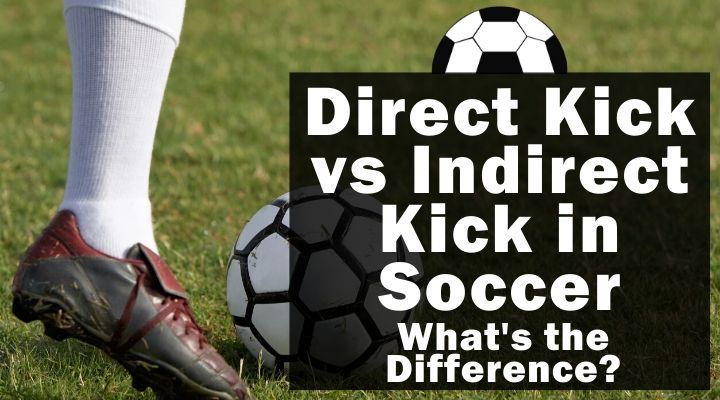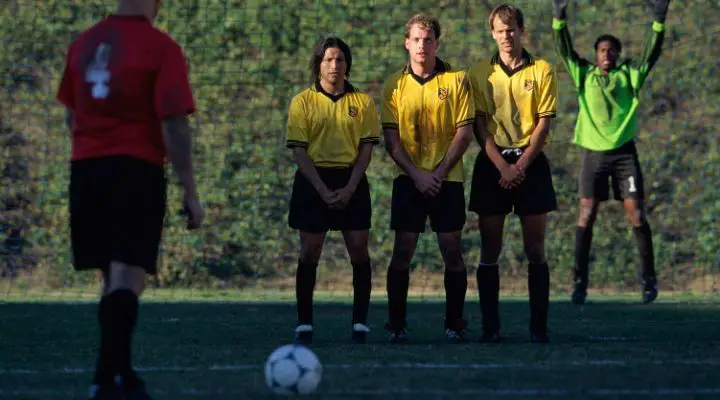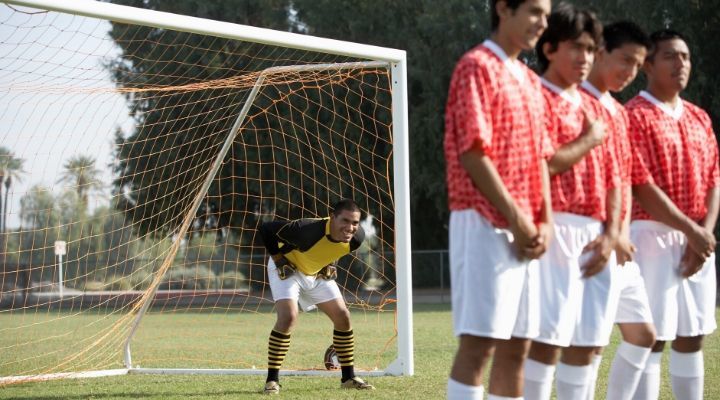

When a player commits a foul out on the soccer pitch, the opposing team is awarded a free kick.
This can either be a direct free kick or an indirect free kick, depending on the infraction.
As a player and coach, it’s important to know the difference between the two as this determines how you line up to both defend and attack each type of free kick.
Let's first take a look to see when each kind is awarded before seeing how play resumes from both a direct free kick and an indirect free kick in soccer.
When the referee blows for a foul and extends their arm horizontally this means that a direct free kick has been awarded.
This type of free kick can be given for a number of different reasons.
The most common cases are when the referee deems an opposition player to have been careless, reckless, or to have used excessive force when:
> Charging an opponent
> Jumping at an opponent
> Kicking or attempting to kick an opponent
> Pushing an opponent
> Striking or attempting to strike an opponent
> Tackling or challenging an opponent
> Tripping or attempting to trip an opponent
> Holding onto an opponent
> Impeding an opponent with contact
A direct free kick may also be awarded if a player other than the goalkeeper commits a handball anywhere on the pitch.
When a player brings the game into disrepute and acts out angrily or violently, a direct free kick may also be awarded to the opposition.
This could be when a player:
> Bites or spits at someone
> Throws an object at the ball or at an opponent or match official
> Commits any physical offense
In rare cases, a direct free kick can also be awarded when:
> A player who requires the referee's permission to re-enter the pitch does so without the match official's permission and interferes with play.
> A substitute, already substituted player, sent-off player, or team official enters the pitch and interferes with play.
All of the above cases see a direct free kick awarded to the team against who the infraction was committed.

When the referee blows for a foul and raises their arm vertically above their head an indirect free kick has been awarded.
This can again be for a number of different reasons although they’re generally less common than the infractions we looked at above.
The most common reason that an indirect kick in soccer is awarded is when a player is caught offside.
Apart from that, it may be because:
> Goalkeeper handled the ball illegally within the penalty area.
> They impeded an opposition player without any contact having been made.
> A player kicked or attempted to kick the ball just when the goalkeeper was releasing it.
> A player impeded or attempted to prevent the goalkeeper from releasing the ball.
> Playing in a dangerous way (without committing another kind of foul or infraction).
> Using abusive, insulting, or otherwise offensive language and / or gestures.
> The player who’s taking the kick-off, a free kick, penalty, throw-in, goal kick or corner mistakenly touches the ball a second time, before it has been touched by anyone else.
> A player illegally and unfairly impedes or distracts the opposition player taking a throw-in.
> A player re-enters the pitch without the referee's permission (but doesn't interfere with the play)
As you can see, these come up relatively infrequently.
The other occasions when a referee may award an indirect free kick instead of a direct free kick all relate to penalties.
This could be because:
> The penalty didn’t go forward.
> The player taking the penalty did an illegal feint to distract the keeper.
> A player other than the identified penalty taker takes the spot kick.
> An attacking player encroaches during the penalty kick and it isn't scored.
> Both the penalty taker and goalkeeper commit an offense at the same time and the kick is scored.
Now that we know when both a direct free kick and an indirect free kick can be awarded, let's take a look at the similarities and differences in how they’re taken.

While there are lots of similarities in terms of how play is restarted from either kind of free kick, there’s a crucial difference between the two.
This is that you’re allowed to score directly from a direct free kick.
This means you can choose to shoot directly on goal from this kind of free kick if you so wish.
Conversely, you’re not allowed to shoot directly at goal from an indirect free kick.
While you can cross or pass to another teammate for them to have a shot or header at goal, if you score directly from this type of free kick it’ll be disqualified and the defending team will be awarded a goal kick.
Apart from this key difference, the rules on how to take both a direct and indirect free kick are largely the same.
This means that:
a. The ball can’t be moving when play is restarted; it must be stationary
b. The ball is only considered to be in play when it’s touched and has moved
c. The player lining up to take the free kick can only touch the ball once
d. The opposition players can stand or form a wall no closer than ten yards from the free kick
e. The free kick must be taken from where the foul or infraction occurred
This last rule has a couple of exceptions to it:
1. If the foul is awarded in the team's own goal area then they may move it wherever they like within that area
2. If the offense or infraction took place off of the pitch, then play is restarted at the nearest point to where it occurred
3. For certain technical offenses, the referee may award an indirect free kick and restart play from where the ball was when the game was stopped
As you can see, direct and indirect free kicks are awarded depending on the severity of the infraction committed.
While the latter are handed out for less serious offenses, direct free kicks are awarded when there has been serious foul play.
As such, the reward is potentially greater as you’re then allowed to shoot directly at goal from the free kick.
Both players and coaches need to know the difference between a direct and indirect kick in soccer as they’re a key part of the beautiful game.